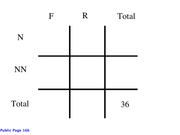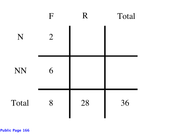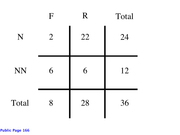After 2/9 of the numbers in a data set A were observed, it turned out that 3/4 of those numbers were non-negative. What fraction of the remaining numbers in set A must be negative so that the total ratio of negative numbers to non-negative numbers be 2 to 1?
a)11/14
b)13/18
c)4/7
d)3/7
e)3/14
[spoiler]OA:A[/spoiler]
tricky fraction
This topic has expert replies
GMAT/MBA Expert
- Brent@GMATPrepNow
- GMAT Instructor
- Posts: 16207
- Joined: Mon Dec 08, 2008 6:26 pm
- Location: Vancouver, BC
- Thanked: 5254 times
- Followed by:1268 members
- GMAT Score:770
Let's PLUG IN a nice value for the total number of values in set A.buoyant wrote:After 2/9 of the numbers in a data set A were observed, it turned out that 3/4 of those numbers were non-negative. What fraction of the remaining numbers in set A must be negative so that the total ratio of negative numbers to non-negative numbers be 2 to 1?
a)11/14
b)13/18
c)4/7
d)3/7
e)3/14
[spoiler]OA:A[/spoiler]
Since we need to deal with the fractions 2/9 and 3/4, it may be useful to choose a value that is the LOWEST COMMON DENOMINATOR of 9 and 4, which is 36.
So, let's say that there are 36 numbers in set A.
2/9 of the numbers in a data set A were observed....
2/9 of 36 is 8
So, 8 numbers were observed, which means 28 numbers were NOT OBSERVED
.... 3/4 of the observed numbers were non-negative
3/4 of 8 is 6
So, 6 numbers were non-negative.
This means that 2 of the observed numbers were NEGATIVE
What fraction of the remaining numbers in set A must be negative so that the total ratio of negative numbers to non-negative numbers be 2 to 1?
We have a total of 36 numbers, and we want the negative numbers to non-negative numbers ratio to be 2 to 1.
In other words, we want there to be a TOTAL of 24 negative numbers and 12 non-negative numbers [since 24:12 = 2:1]
We have already observed 2 negative numbers, so we need 22 more negative numbers from the NON-OBSERVED portion.
In other words, we want 22 of the unobserved 28 numbers to be negative.
22/28 = [spoiler]11/14 = A[/spoiler]
Cheers,
Brent
GMAT/MBA Expert
- [email protected]
- Elite Legendary Member
- Posts: 10392
- Joined: Sun Jun 23, 2013 6:38 pm
- Location: Palo Alto, CA
- Thanked: 2867 times
- Followed by:511 members
- GMAT Score:800
Hi buoyant,
I'm a big fan of TESTing VALUES (the approach that Brent showed). This question can also be solved algebraically; you just have to be careful about labeling your work.
We're told that 2/9 of a group of numbers are observed and that 3/4 of that group were NON-negative.
X = total number of terms
(2/9)X = number of terms observed
(3/4)(2/9)X = (6/36)X = 1/6X of the terms in the set are NON-negative....so far....
We're asked what fraction of the remaining (7/9) terms must be NEGATIVE so that the ratio of NEGATIVE to NON-negativei is 2:1
With a ratio of 2:1, that translates into 2/3 NEGATIVE, 1/3 NON-negative
Since we already have data about the number of NON-negative terms (1/6 so far), I'm going to stay focused on the number of NON-negative terms...We need ANOTHER 1/6 of the X terms to be NON-negative (since 1/6 + 1/6 = 1/3.
We need to calculate what the fraction of the remaining (7/9) terms would have to be NON-negative to give us the extra 1/6 that we're looking for. That calculation would be....
Y(7/9) = 1/6
Y = 9/42
Y = 3/14
This is the fraction that would have to be NON-negative. The question asks us for the fraction that would have to be NEGATIVE though, so there's one more step...
1 - 3/14 = 11/14
Final Answer: A
GMAT assassins aren't born, they're made,
Rich
I'm a big fan of TESTing VALUES (the approach that Brent showed). This question can also be solved algebraically; you just have to be careful about labeling your work.
We're told that 2/9 of a group of numbers are observed and that 3/4 of that group were NON-negative.
X = total number of terms
(2/9)X = number of terms observed
(3/4)(2/9)X = (6/36)X = 1/6X of the terms in the set are NON-negative....so far....
We're asked what fraction of the remaining (7/9) terms must be NEGATIVE so that the ratio of NEGATIVE to NON-negativei is 2:1
With a ratio of 2:1, that translates into 2/3 NEGATIVE, 1/3 NON-negative
Since we already have data about the number of NON-negative terms (1/6 so far), I'm going to stay focused on the number of NON-negative terms...We need ANOTHER 1/6 of the X terms to be NON-negative (since 1/6 + 1/6 = 1/3.
We need to calculate what the fraction of the remaining (7/9) terms would have to be NON-negative to give us the extra 1/6 that we're looking for. That calculation would be....
Y(7/9) = 1/6
Y = 9/42
Y = 3/14
This is the fraction that would have to be NON-negative. The question asks us for the fraction that would have to be NEGATIVE though, so there's one more step...
1 - 3/14 = 11/14
Final Answer: A
GMAT assassins aren't born, they're made,
Rich
- GMATGuruNY
- GMAT Instructor
- Posts: 15539
- Joined: Tue May 25, 2010 12:04 pm
- Location: New York, NY
- Thanked: 13060 times
- Followed by:1906 members
- GMAT Score:790
This is an EITHER/OR group problem.buoyant wrote:After 2/9 of the numbers in a data set A were observed, it turned out that 3/4 of those numbers were non-negative. What fraction of the remaining numbers in set A must be negative so that the total ratio of negative numbers to non-negative numbers is 2 to 1?
a)11/14
b)13/18
c)4/7
d)3/7
e)3/14
[spoiler]OA:A[/spoiler]
Every number is a member of EITHER the first group of numbers OR the remaining numbers.
Every number is EITHER negative OR non-negative.
For an EITHER/OR group problem, use a GROUP GRID (also known as a double-matrix) to organize the data.
Let F = first group, R = remaining, N = negative, NN = non-negative.
Let the total number of numbers in set A = the LCM of the denominators in the problem = 9*4 = 36.
Here is the grid:

In a group grid, the entries in any given row or column must sum to the TOTAL of that row or column.
After 2/9 of the numbers in a data set A were observed, it turned out that 3/4 of those numbers were non-negative.
Thus:
Total F = (2/9)(36) = 8.
Non-negative in F = (3/4)(8) = 6.
The following grid is yielded:

The total ratio of negative numbers to non-negative numbers is 2 to 1.
Since 2 of every 3 numbers in set A must be negative, we get:
Total N = (2/3)(36) = 24.
Total NN = 36-24 = 12.
The following grid is yielded:

What fraction of the remaining numbers in set A must be negative?
In the resulting grid:
(negative numbers in R)/(total R) = 22/28 = 11/14.
The correct answer is A.
Private tutor exclusively for the GMAT and GRE, with over 20 years of experience.
Followed here and elsewhere by over 1900 test-takers.
I have worked with students based in the US, Australia, Taiwan, China, Tajikistan, Kuwait, Saudi Arabia -- a long list of countries.
My students have been admitted to HBS, CBS, Tuck, Yale, Stern, Fuqua -- a long list of top programs.
As a tutor, I don't simply teach you how I would approach problems.
I unlock the best way for YOU to solve problems.
For more information, please email me (Mitch Hunt) at [email protected].
Student Review #1
Student Review #2
Student Review #3
Followed here and elsewhere by over 1900 test-takers.
I have worked with students based in the US, Australia, Taiwan, China, Tajikistan, Kuwait, Saudi Arabia -- a long list of countries.
My students have been admitted to HBS, CBS, Tuck, Yale, Stern, Fuqua -- a long list of top programs.
As a tutor, I don't simply teach you how I would approach problems.
I unlock the best way for YOU to solve problems.
For more information, please email me (Mitch Hunt) at [email protected].
Student Review #1
Student Review #2
Student Review #3
-
Matt@VeritasPrep
- GMAT Instructor
- Posts: 2630
- Joined: Wed Sep 12, 2012 3:32 pm
- Location: East Bay all the way
- Thanked: 625 times
- Followed by:119 members
- GMAT Score:780
Here's a much faster algebraic approach:
What we know:
(2/9)(1/4)x, or (1/18)x is negative.
What we want:
(2/3)x is negative.
Let's call z the fraction of the remaining numbers that will be negative. Since we have (7/9)x remaining, we'll say that z*(7/9x) is the remaining amount of negative numbers.
(1/18)x + z*(7/9)x = 2/3x
Dividing by x, we have
(1/18) + (7z)/9 = 2/3, or
(7z)/9 = 11/18, or
(7z) = 11/2, or
z = 11/14
What we know:
(2/9)(1/4)x, or (1/18)x is negative.
What we want:
(2/3)x is negative.
Let's call z the fraction of the remaining numbers that will be negative. Since we have (7/9)x remaining, we'll say that z*(7/9x) is the remaining amount of negative numbers.
(1/18)x + z*(7/9)x = 2/3x
Dividing by x, we have
(1/18) + (7z)/9 = 2/3, or
(7z)/9 = 11/18, or
(7z) = 11/2, or
z = 11/14




















